| Tweet
|
|
The
Star Larvae Hypothesis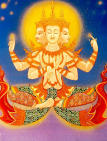
Nature's Plan for Humankind
Part 2. Star Larvae
Astrolatry, Astrotheology and Astral Religion
The universality and persistence of astral themes in religious art and lore testify to humankindís stellar calling.
So far as the experts have determined, humankind's earliest religious conceptions cast the universe in the role of living organism.
Nature expresses its animate character through every occurrence, from the metamorphosis of an insect to the cycle of the seasons. In this vitalistic understanding, the stars enjoy a special status: they are more than merely alive; they are divine. Those twinkles that dot the night sky are nearer to God than we. Nonetheless, the stars take an interest in human affairs, or so some ancients held.
Although contemporary thought regards the situation very differently, the star larvae hypothesis defends the old conception. It regards the prevalence and persistence of astral themes in the world's religions as not only an echo of the shamanic roots of religion per se, but also as a portent of (post)human destiny. The hypothesis asserts that stars constitute the human imago. What follows is a brief chronology that documents the prevalence and persistence of astral themes in religious history (or, at least, in European religious history). These data are presented as nontechnical—humanistic—evidence in support of the hypothesis.
— Carl
Jung
Psychology
and Alchemy (Collected Works of C.G. Jung Vol.12)
Astrotheology and Shamanism
Stellar allusions
appear early in the history of religions. In Shaman:
The Wounded Healer anthropologist Joan Halifax explains that the shamanic "realization of a solar identity" experienced by the
tribal priest reveals to her or him
the
"deepest structures of the psyche." The shamanic practices of hunter-gatherer
societies rely on drugs, fasting, dance and other trance-inducing techniques
to produce a state of religious ecstasy. In this state, the shaman feels as if
she or he receives personally
and communally meaningful information from an astral dimension. In her survey of shamanic traditions,
Halifax includes examples of shamanic art that depict human forms embellished with radiant auras and interprets such images as expressions of the psyche's core.
If shamanism, with its emphasis on direct transcendental experience, typifies hunter-gatherer societies, then a ceremonialized expression of the stellar calling seems to be the derivative religious form in agrarian societies. When human societies organized themselves around farming, then rituals, ceremonies, and pageantries tended to supplant personal revelation as the focus of religious life. Human labor became increasingly fragmented, and other influences—lunar, atmospheric, and finally terrestrial—gave rise to pantheons, doctrines, and creeds. The religious sensibility's solar orientation got grounded and became vitiated among these competing influences.
But a handful
of civilizations, rather than sprout a pantheon of nature gods, remained
steadfastly solar. Mircea Eliade, in Patterns
in Comparative Religion,
characterizes a peculiarity of the most consistently sun-centric civilizations.
A solar deity remained the primary focus of the local religion, he
observes, in those civilizations that came to exercise the greatest
historical import.
"It is really only in Egypt, Asia, and in primitive Europe that what we call sun worship ever attained sufficient popularity to become at any time, as in Egypt for instance, really dominant. If you consider that, on the other side of the Atlantic, the solar religion was developed only in Peru and Mexico, only, that is, among the two 'civilized' peoples of America, the only two who attained any level of real political organization, then you cannot help discerning a certain connection between the predominance of sun religions and what I may call 'historic' destinies. It could be said that where 'history is on the march,' thanks to kings, heroes, or empires, the sun is supreme."
The star larvae hypothesis takes this observation as a recommendation.
 |
Spiritual attainment is expressed as solarization in renderings from Australia (left) and Mexico (right). | 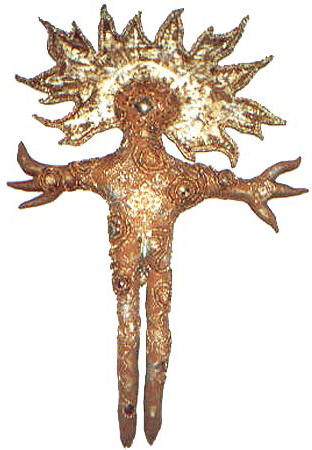 |
Astrotheology in the Classical World
 "The
Rosicrucians and the Illuminati, describing the angels, archangels,
and other celestial creatures, declared that they resembled small suns, being centers of radiant energy surrounded by streamers of Vrilic force.
From these outpouring streamers of force is derived the popular belief
that angels have wings. These wings are corona-like fans of light, by means
of which the celestial creatures propel themselves through the subtle essences
of the superphysical worlds."
"The
Rosicrucians and the Illuminati, describing the angels, archangels,
and other celestial creatures, declared that they resembled small suns, being centers of radiant energy surrounded by streamers of Vrilic force.
From these outpouring streamers of force is derived the popular belief
that angels have wings. These wings are corona-like fans of light, by means
of which the celestial creatures propel themselves through the subtle essences
of the superphysical worlds."
-—
Manley Palmer Hall
The
Secret Teachings of All Ages
In Astrology
and Religion Among the Greeks and Romans,
Franz Cumont traces throughout the classical world the spread of astrotheology
and astral mysticism, essentially a deification of astrophysical phenomena. A striking form of stellar significance in the ancient world was
Catasterism, the metamorphosis of ascended heroes into constellations, casting the star as the endpoint of the heroic journey:
"In Plato's view souls which have made a good use of their lives return to inhabit the heavenly bodies, which served as their dwelling-place before birth, and there partake of the bliss of a divine existence. Moreover, the Greeks [. . . ] had long before told how certain heroes of fable had been transported to heaven in reward for their exploits. Hercules, Perseus and Andromeda, the Dioscuri Castor and Pollux, and many others had thus been metamorphosed into constellations. 'Catasterism' forms the dénouement of a number of mythological stories."
— Frances
A. Yates
Giordano
Bruno and the Hermetic Tradition
"The horses of fire and the chariot of fire, which carried Elijah in a whirlwind, are very probably the horses and chariot of the Sun. In the same way, when Mithra's mission on earth was fulfilled, he had been conveyed in the chariot of Helios to the celestial spheres [. . . .] The Emperors in particular were commonly reputed to become companions of the Sun-god after death, as they had been his proteges in life, and to be conducted by him in his chariot up to the summit of the eternal vaults."
The star larvae hypothesis embraces this latter—somatic—form of the motif and so commends Christianity for its atavism, for grounding its dogma in the physical, bodily ascent of Jesus. (For a broader, historical, application, the forementioned chariots will morph into rockets.)
The apostle Paul underscored the theme of ascension as realization when he described the return of Christ from his airborne abode, in his first letter to the Thessalonians:
"For the Lord himself will descend from heaven with a cry of command, with the archangel's call, and with the sound of the trumpet of God. And the dead in Christ will rise first. Then we who are alive, who are left, shall be caught up together with them in the clouds to meet the Lord in the air; and so we shall always be with the Lord."
During Christianity's early days, at least one heretical sect, the Manichaean
branch of Gnosticism, held tight to the identification of spirit with cosmos,
of the solar with the divine. Joan O'Grady, in Early
Christian Heresies, summarizes
the Manichaean scheme.
"According to the Manichaean myth, Satan invaded the Kingdom of Light. To fight against him, God created Primal Man, who was, for the Manichees, an Archetype—an original ideal pattern, not the first human being. Satan overcame his opponent and, although Primal Man was rescued by God, Satan robbed him of some particles of light and mingled these with five elements of the dark world. Out of these mixed elements God formed the visible world in order to deliver the imprisoned light. Primal Man and his helping spirits dwell in the Sun, and the twelve constellations collect any particles of light set free and pour them into the Sun. Here they are purified and can attain to God."
Persisting through Chaldean astrology and its influence on Hellenic thought and into medieval Christian theology and on into the revival of Hellenism during the Renaissance, the astral motif retained a prominent place in Western religious sensibility. The divine status of stars crossed effortlessly from the Pagan to the Christian world. It passed from Patristic Fathers, such as Origen, on through medievalism's retention of Aristotelian cosmology, to Renaissance philosophers, such as Ficino, Bruno and the later angelologists, such as Dee and Fludd. It was fundamental to Hermetic magic as well and has a discernible counterpart in Jewish Kabbalism and older Jewish tradition.
C. S Lewis, in "The Discarded Image," references the special status of sun and stars in the Medieval and Renaissance model of nature. That model included a triadic aspect, and this cosmic Triad, “can be envisaged not only as a harmony but as a polity, a triad of sovereign, executive and subjects; the stellar powers command, the angelic beings execute, and the terrestrials obey.”
In that passage, stars reign as sovereigns. But elsewhere Lewis comments, “The question at once arises whether Medieval thinkers really believed that what we now call inanimate objects were sentient and purposive. The answer in general is undoubtedly ‘no.’ I say ‘in general’ because they attributed life and even intelligence to one privileged class of objects (the stars) which we hold to be inorganic” (Parentheses in original).
In that passage, stars, though living and intelligent, rate only a parenthetical status, though one acknowledged as privileged. Elsewhere in the book Lewis also acknowledges the privileged status of the sun, but seemingly so as to dismiss it.
“In xvii [of Cicero’s Somnium Scipionis, or Dream of Scipio] (if it will not be thought too trifling) we may notice that the Sun is the world’s mind, mens mundi. Ovid (Met. iv, 228) made it mundi oculus, the world’s eye. The elder Pliny (Nat. Hist. ii, iv) reverted to Cicero with a slight change: mundi animus. Bernardus Silvestris used both honorifics—mens mundi . . . mundanusue oculus. Milton, who had presumably not read Bernardus but had certainly read the Somnium and Ovid and probably Pliny, does the same, ‘Thou Sun, of this great world both eye and soul; (P.L. v,171). Shelley, perhaps with Milton only in mind, raises the eye image to a higher level: ‘the eye with which the universe Beholds itself and knows itself divine.’ (Hymn of Apollo, 31).
“Far more important than such curiosities, however, is the general character of this text which is typical of much material which the Middle Ages inherited from antiquity.”
It’s not clear why these solar allusions are “trifling” or “curiosities” when they were, as much as any other aspect, ingredients of the Medieval-Renaissance model of nature. Lewis had an odd slant on the supposed special status of the sun and stars. Perhaps he felt it an unwelcome inheritance that Christianity received from pagan tradition.


— Carl
Jung
Psychology
and Alchemy (Collected Works of C.G. Jung Vol.12)
Astrotheology in the Renaissance and the Enlightenment
During the
Renaissance, the revival of Hermetic-Hellenic philosophies brought
with it a marked stellar influence, as Frances Yates describes in Giordano
Bruno and the Hermetic Tradition,
"Egypto-Hermetic sun-teachings undoubtedly influenced [Marsilio] Ficino's sun-magic, and they connected philosophically with Plato on the sun as the intelligible splendour, or chief image of the ideas, and religiously with the Pseudo-Dyonysian light symbolism. All these influences can be perceived, working together, in Ficino's De sole and De lumine. As we have tried to to outline in previous chapters, the concentration on the sun in the astral magic, led upwards through the Christian Neoplatonism of Pseudo-Dionysus to the supreme Lux Dei, and in this way the sun very nearly is for Ficino what it is for Hermes or for the Emperor Julian, the 'second god', or the visible god in the Neoplatonic series."
Later, during the Enlightenment, American revolutionary Thomas Paine adamantly defended his belief that Christianity grew from astrological sources. In his Essay on the Origins of Freemasonry he explains,
"The Christian religion and Masonry have one and the same common origin: both are derived from the worship of the sun. The difference between their origin is, that the Christian religion is a parody on the worship of the sun, in which they put a man whom they call Christ, in the place of the sun, and pay him the same adoration which was originally paid to the sun, as I have shown in the chapter on the origin of the Christian religion.
In Masonry many of the ceremonies of the Druids are preserved in their original state, at least without any parody. With them the sun is still the sun; and his image in the form of the sun is the great emblematical ornament of Masonic lodges and Masonic dresses. It is the central figure on their aprons, and they wear it also pendant on the breast of their lodges, and in their processions. It has the figure of a man, as at the head of the sun, as Christ is always represented."
 In
a letter
to his friend, Andrew Dean, Paine elaborates,
In
a letter
to his friend, Andrew Dean, Paine elaborates,
"Everything told of Christ has reference to the sun. His reported resurrection is at sunrise, and that on the first day of the week; that is, on the day anciently dedicated to the sun, and from thence called Sunday - in Latin Dies Solis, the day of the sun; and the next day, Monday, is Moon-day. But there is no room in a letter to explain these things."
Web sites such as Zeitgeist, The Pharmacratic Inquisition, and Truth Be Known present other aspects of the case for Christianity's astronomical/astrological origins. The coronal treatments of Jesus, Mary, and the saints in Catholic art, among other symbols, preserve the astral connection. Jesus' transfiguration is an overt premonition of stardom. But Jesus is not alone. Lesser celebrities also report the experience. From the biography of a medieval Christian mystic, Mircea Eliade cites a dramatic account of a transfiguration experience:
"As this light continued to shine with ever increasing brightness and became like a midday sun shining in splendour above him, he saw that he was himself at the centre of the light and that the sweetness invading his whole body from so near filled him with joy and tears. He saw the light unbelievably uniting with his flesh and gradually pervading his limbs. He saw this light finally invading his body, his heart and his bowels, the whole light invading his whole body and turning him completely to fire and light."
"And
those who are wise shall shine like the brightness of the firmament;
and those who turn many to righteousness, like the stars for ever and
ever."
— Daniel
12:3
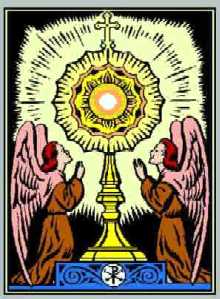
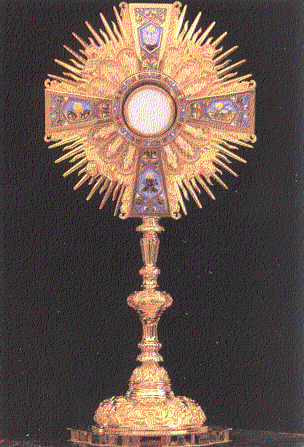
— Omraam Mikhael
Aivanhov
Toward
a Solar Civilization
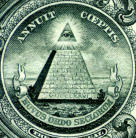 In The
Two and the One
In The
Two and the One,
Eliade collects this and similar accounts of what he calls "the
mystical light." The Buddhists' "clear white light of the
void" and similar metaphors evince the universality of the stellar
archetype. Eliade documents varieties of mystical experience that
include not only the mystical light, but also "mystical flight," the
sensation of ascent, along with instances of precognition, an
intuitive sensing of future events. This complex of motifs argues
for a stellar core at the heart of religious sensibility, a core that will spill into history, according to our hypothesis..
Evidence of these themes throughout the world's religious traditions points to a well-developed complex in the human psyche that revolves around stellar attributes and anticipates human participation in the stellar life cycle. We star-struck, starry-eyed humans are driven toward the heavens by our stellar nature.
"Every man and every woman is a star," declared the notorious English occultist Aleister Crowley. Through his hermetic investigations he had distilled the collective calling of humankind. Today, illuminated entities, enlightened beings, and ascended masters populate the firmaments and astral planes of "New Age" cults as readily as they did the ancient occult cosmologies.
The halos, auras, nimbuses, and coronas that crown the assumptive and ascending heads of Catholic, Hermetic, and Alchemical sacred art testify to the archetypal pull of the solar. In today's pop culture, the revered, adored, and glorified luminaries are called by their fans, "stars." The star larvae hypothesis suggests that even such an innocuous convention as this evinces a nascent intuition of the evolutionary program. Stardom resides in terrestrial human beings and expresses itself psychologically as the illumination or enlightenment of the individual and collectively as the cult(ure) of the sun and of a future Heaven beyond Earth to be attained by ascension.
But the star larvae hypothesis is more than an exposition of archetypal psychology. It proposes that the archetype of the astral divinity is a blueprint for historical destiny, a premonition. Humankind's religious sensibility just needs to shift its urging from posthumous adventures to that of engineering extraterrestrial niches to house a posthumanity, that is, a transfigured humanity.
NEXT > Silicates
and Biogenesis

The Empyrean, by Gustav Doré, from The Divine Comedy
"I saw the best minds of my generation destroyed by madness, starving hysterical naked, dragging themselves through the negro streets at dawn looking for an angry fix, angelheaded hipsters burning for the ancient heavenly connection to the starry dynamo in the machinery of night." —-
Allen Ginsberg |
![]()
The Star Larvae Hypothesis:
Stars constitute a genus of organism. The stellar life cycle includes a larval phase. Biological life constitutes the larval phase of the stellar life cycle.
Elaboration: The hypothesis presents a teleological model of nature, in which††-
Stellar nebula manufacture bacteria and viruses in their interiors as they cool.
-
Biology evolves within an ontogenetic program that in its entirety, on- and off-planet, constitutes a generational life cycle of the stellar organism.
-
Technology plays a necessary role in evolution. It enables biological life to emigrate from planets to weightless space.
-
Postplanetary life manufactures the protons needed to create, then metamorphoses into, new stars.
-
A prescient complex of celestial religious motifs expresses humankind’s stellar calling. The star is the human imago.
-
Nature's metabolism encompasses the organic and the inorganic in a continuum of anabolic and catabolic exchanges.
| Tweets by @Starlarvae | |
| |
Home | Blog | About | Videos | Contact | Text Copyright ©2004-2017 Advanced Theological Systems. All Rights Reserved.
Privacy Statement: We use third-party advertising companies to serve ads when you visit our website. These companies may use information (not including your name, address, email address, or telephone number) about your visits to this and other websites in order to provide advertisements about goods and services of interest to you. If you would like more information about this practice and to know your choices about not having this information used by these companies, visit the Google ad and content network privacy policy.